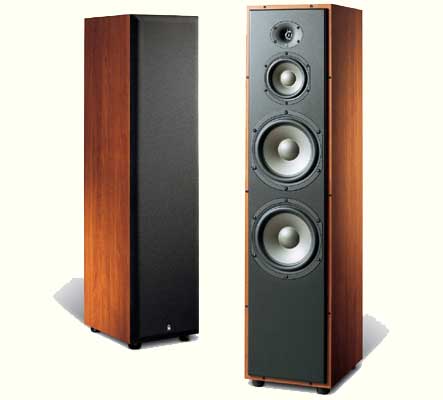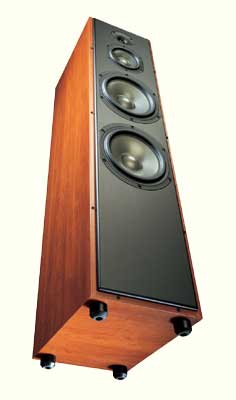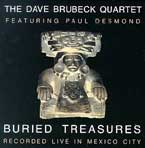Introduction
Revel is part of the Harman Specialty Group, which includes such well-known
brands as Mark Levinson and Lexicon. The luxury of being part of a company
as large as the Harman Group is, in a word, resources.
Revel has access to a
vast array of engineering and evaluation tools. For example, using laser interferometry, which utilizes the interference of
light waves for
precise determinations of distance or wavelength, Revel's R & D department
performs a very detailed driver and cabinet analysis.
In addition, Revel has
access to multiple anechoic chambers, which enable precise speaker tests and
measurement data.
Finite element analysis further provides for advanced
loudspeaker modeling, while a stereo lithography apparatus aids in achieving
tight manufacturing tolerances.
Finally, a state-of-the-art, multi-channel
listening lab allows for double-blind listening tests. This was used in pursuit of Revel's
stated goal for the Concerta series - the reproduction of the source signal
with greater accuracy than any other loudspeakers in their price category.
Ambitious? Indeed, but Revel has compiled a track record which is the envy
of many a speaker manufacturer (both the Ultima and Performa Series have
received rave reviews by consumers and the press).
The Concerta series
represents Revel's maiden voyage into a much lower price category than its
previous entry-level line, the Performa series. To give an idea just how big
a jump down in price this represents, the F12's counterpart in the Performa
series, the F32, has an MSRP of $4,000/pair. That is a hefty $2,700 differential.
I
owned the F32's predecessor, the F30, and I thought it was one of the most
communicative, articulate speakers I had ever heard under $5,000/pair. I
reluctantly let it go for a more efficient speaker, but it was definitely
missed. I anxiously awaited the return of the Revel sound to my home and the
comparison to the PSB Stratus Gold i, which replaced the F30. I heard the F12
at the designer, Kevin Voeck's, home in March of this year and came away
very impressed, especially considering the price. Even though the PSB has an
MSRP double that of the F12, my initial impression of the F12 was that it
would not be embarrassed, and I looked forward to hearing the Revel in my own
system.
 The
Revel Concerta F12 is a three-way, full-range loudspeaker comprised of four
proprietary drivers, which include one 1" tweeter, a 5-14" midrange driver,
and two 8" woofers.
The
Revel Concerta F12 is a three-way, full-range loudspeaker comprised of four
proprietary drivers, which include one 1" tweeter, a 5-14" midrange driver,
and two 8" woofers.
All the drivers
are made from an organic ceramic composite (OCC) material, which Revel chose
for its low distortion characteristics. The tweeter features a unique
waveguide for what the manufacturer claims is seamless integration, even
off-axis, between the midrange and the high frequencies.
Revel claims the
F12's frequency response is 33 Hz to 18 kHz ± 1dB, and that the use of a
high-order, three-way filter network (crossover), at 575 Hz and 3.0 kHz, provides
for wide dynamic range without compression. Revel states sensitivity at 90.5
dB and a nominal impedance of 6 ohms.
Since it is magnetically shielded, the F12
may be placed close to CRT video monitors. The vinyl-wrapped (which looks like
anything but) MDF cabinet is available in Natural Cherry, Maple, or Black
Ash. The vinyl finish deserves special note because I have never seen a
vinyl finished speaker look this good. In fact, the F12 looks quite a bit
better than many real wood veneered speakers I have owned.
The F12 has a
very sleek, modern appearance and should be very easy to place. It
is rear ported and features dual sets of gold plated, five-way binding posts.
Each speaker measures 42.3" H (including feet) x 9.75" W x 14.3" D
(including grille) and weighs 62.6 pounds.
 Set-Up
Set-Up
My review system for the F12 consisted of the
aforementioned PSB Stratus Gold i speakers, DK Design Group VS I Reference Mk. II
integrated amplifier, a Music Hall MMF CD-25 CD player, Denon DVD-910 DVD
player, Analysis Plus speaker and interconnect cables, and Shunyata Research Hydra-6 and
Diambondback AC cords on both the amplifier and CD player.
I've had the PSBs
almost two years now, and have reviewed only one other speaker (Von Schweikert
VR2) since I purchased them, so it was rather strange to walk them out of
the way to make room for the much more svelte F12s.
The F12s rest on hard
rubber feet, and Revel includes thin spikes that thread through the middle
of the hollow footer and into the speaker cabinet. As a result, most of the
spike gets hidden inside the footer and, at least aesthetically, this is a
nice solution. Functionally, however, you don't have much spike to work with
as you try to level the speakers on your floor, so the design rewards strong
fingers.
Positioning the F12s was very easy. There is some
golden formula of speaker placement out there, but I cannot realistically
achieve it in my living room (22'L x 15'W x 10'H), so I ended up placing the
speaker about 24 inches from the side wall and 39 inches from the rear wall.
The speakers were about 11 feet from each other and from my listening
position. I left the speakers pointing straight forward, took the grilles
off, put a CD on repeat, and walked away.
Initially, the lack of bass compared to the PSB made me cringe.
Listening
 I
gave the speakers a continuous signal for 24 hours or so and then took a
seat in front of them to get some idea of what the speaker was about. The
first CD I played was Cat Power You Are Free (Matador Records). Cat Power is
the creation of Chan Marshall and besides some guest appearances (Dave Grohl
– drums; Eddie Vedder - vocals) on certain songs, it is generally just her
singing and either playing the guitar or the piano.
I
gave the speakers a continuous signal for 24 hours or so and then took a
seat in front of them to get some idea of what the speaker was about. The
first CD I played was Cat Power You Are Free (Matador Records). Cat Power is
the creation of Chan Marshall and besides some guest appearances (Dave Grohl
– drums; Eddie Vedder - vocals) on certain songs, it is generally just her
singing and either playing the guitar or the piano.
Style-wise, Cat Power
might be thought of as a female Elliott Smith. Of course, this does not at
all tell the complete story, and I highly recommend the free download of the
Cat Power track “He War” on Amazon, as it is a good example of her sound – a
bit raw both emotionally and technically. On the initial listen, I was
struck by just how much the fullness of the PSBs was lacking. I decided to
toe the speakers in a bit and they remained in that position throughout the
review.
I played the Cat Power CD again after several months of listening to
the speakers almost every day with all kinds of sources, including XBox,
DVD, and HDTV, and my notes in listening to the different songs on the album
illustrate what I came to realize was a particular strength of the F12s, a
wonderful, non-fatiguing clarity.
“Free,” song number two on the album, features that distinctive chirping
sound that guitar strings make when a hand slides along the neck of a
guitar, as it reaches for new notes. The more tightly the strings on the
neck of the guitar are held, the less sound the strings make as the hand
travels up or down.
The F12 was outstanding at both placing the guitar just
left of center and revealing how tightly Chan held the strings as she made
her way through the changes in the song. This was something I had never
noticed with the PSBs. At that moment, I knew this comparison would be
problematic because it is a very difficult thing to choose between the
satisfaction that the PSB's fullness provided, versus the newfound precision
with which the sound of F12s were endowed.
At the time, I could easily imagine
preferring either, depending on my mood and the recording. I decided to
withhold such a premature judgment and just continue to listen.
The Revels
seemed to have a more focused presentation than the PSBs, and it was precisely
in keeping with my memory of the F30. When I switched from the F30s to the PSBs, I do not remember, however, noticing that the PSBs provided more
fullness than the F30. My memory is that both speakers were similar in that
regard.
Accuracy is a priority of Revel, and based on my
experience, a goal they consistently hit. The wonderful thing about the
F12's precision, is that it does not enter the realm of the
hyper-analytical, nor does the sound strike me as abnormally thin. It seems,
in fact, realistic, and while reality is not always pleasant, it often
provides for magical results. Track three, “Good Woman,” features some
background vocals, which have a slight panting quality to them. The F12s gave
the vocals their own place in the soundstage, and the balance seemed better
than what I remembered from the PSBs, which buried the backing vocals a bit.
Track seven, “He War,” was where the scale of the soundstage that the PSBs
portrayed was missed. While the percussion and inner detail were more
realistic through the F12s, the overall effect of the track was less
satisfying. As on track two, the F12s again hit their stride on track nine.
The introduction to the song, “Babydoll,” features some very well-recorded
guitar and vocals, as well as a layer of guitar distortion underneath parts
of the track.
Listening to this song on the F12s, one can actually hear Chan
wet her lips, and I even pictured her closing her eyes each time she took a
breath before she sang. I'm not saying you can hear her eyes close, but
rather, the overall effect of the presentation is that you are there; it is
one of those moments of intimacy that results from the strange, wonderful
alchemy of art and technology.
And so it was with the rest of the album,
moments of eerie realism, as well as the occasional thought that I wished the
sound was a bit fuller. Nowhere is accuracy more important than the midrange,
and this track, through the F12, clearly conveyed the aching beauty of
Chan's voice.
 The
next CD I decided to spend some time with was Radiohead's Kid A (Capitol).
While this is not my favorite Radiohead album, I feel strongly that every piece of
equipment that comes through my house must be put to the test of at least
one Radiohead album, and I know I was wearing out Amnesiac, so Kid A got the
call. Track one, “Everything In Its Right Place,” showcases the F12's ability
to accurately convey the song's lightning fast left-to-right transients.
The
next CD I decided to spend some time with was Radiohead's Kid A (Capitol).
While this is not my favorite Radiohead album, I feel strongly that every piece of
equipment that comes through my house must be put to the test of at least
one Radiohead album, and I know I was wearing out Amnesiac, so Kid A got the
call. Track one, “Everything In Its Right Place,” showcases the F12's ability
to accurately convey the song's lightning fast left-to-right transients.
The
F12s provided the avenue through which my connection and response to the
sound happening around me was possible. I'm referring to the spooky feeling
that instead of just hearing sound, the music actually communicates
something to you. The interesting thing to me about much of Radiohead, is
that my listening experience depends largely upon my mood, and so I
notice different things about the songs on different occasions.
Much of what is satisfying to me about recorded
music depends on the ability of playback equipment to get the pace correct.
The F12s slightly edged the PSBs in this regard, and the entire Radiohead album
benefited from the quickness with which the F12s could start and stop. Track
eight, “Idioteque,” deserves special mention because it includes truly deep
bass information. The F12s had no problem with the low frequencies, and if I
didn't know better, I would have thought the sound was supplemented with a
subwoofer. The bass was less room-filling than with the PSBs, but it was
tighter, more a sound I heard than an effect I felt in the floor. Track
10, “Motion Picture Soundtrack,” very nicely illustrates the advantage I had
come to expect of the F12s, the ability to play and release individual notes
with stunning accuracy.
 While
I won't detail, track by track, my impressions of all the other albums I
enjoyed on the F12s, I will note some highlights. On The Dave Brubeck
Quartet Buried Treasures (Sony), which is a live recording from a concert in
Mexico City in 1967, I played the F12s at near concert level volumes, and
never once did I find myself scrambling for the volume control, even when the
alto saxophone of Paul Desmond threatened to split my walls and my ears. It
had been awhile since I really listened to the CD, and I remembered why it is
one of my favorite Brubeck recordings.
While
I won't detail, track by track, my impressions of all the other albums I
enjoyed on the F12s, I will note some highlights. On The Dave Brubeck
Quartet Buried Treasures (Sony), which is a live recording from a concert in
Mexico City in 1967, I played the F12s at near concert level volumes, and
never once did I find myself scrambling for the volume control, even when the
alto saxophone of Paul Desmond threatened to split my walls and my ears. It
had been awhile since I really listened to the CD, and I remembered why it is
one of my favorite Brubeck recordings.
Whether it is due to the remastering
or the original recording itself, the sound of this disc is very clear, and yet with an
ever so slight patina of warmth. It makes the recording exceedingly
pleasant, yet doesn't rob the concert of its energy and excitement. All the
bite of the brass is there, and indeed, Desmond's saxophone is, at times,
piercing, but there is none of the banal sterility that I sometimes encounter in
jazz recordings. Additionally, Joe Morello's drum work on the record is
inspired, and of course, Dave's playful performance on the piano comes
through in all its glory.
 I
watched Pearl Harbor on DVD in order to get an idea what the F12s could do
with a sound effects-laden DVD. Again, while the smaller F12s gave up some
of the grandeur that the PSBs so effortlessly conveyed, it proved very adept
at sorting the complex interplay of dialogue, music, and sound effects. In
order to get the deep bass from DVD on the F12s, however, I had to turn up
the volume more than I was used to on the PSBs.
I
watched Pearl Harbor on DVD in order to get an idea what the F12s could do
with a sound effects-laden DVD. Again, while the smaller F12s gave up some
of the grandeur that the PSBs so effortlessly conveyed, it proved very adept
at sorting the complex interplay of dialogue, music, and sound effects. In
order to get the deep bass from DVD on the F12s, however, I had to turn up
the volume more than I was used to on the PSBs.
For those of you who must
have more bass, Revel makes a $999 subwoofer in the Concerta line, the B12,
which would likely fill whatever perceived deficiency one might find in the
bass response of the F12s. I only noticed this when trying to pull off theater style
volume levels with DVD. Anyone serious about
theater should investigate the full Concerta line, as it includes all the
speakers you need for true home theater.
Conclusions
The fact that I continued to make very favorable
comparisons and distinctions with the PSB Stratus Gold i, which I regard as
one of the best buys in audio at $2,599/pair, should clue you into how much I
enjoyed the Revel Concerta F12s. At half the price, the Revel is an
outstanding bargain.
The F12s repeatedly showed themselves as accurate transducers of
whatever I fed them, and with none of the negatives typically associated with
that hackneyed phrase. I won't say that they are better than the PSBs, but with
many CDs, I was more interested in the recording because I heard deeper into
it with the F12s.
The PSBs have always been a joy to listen to, which is why I have
owned them for so long, but the Revels provided excitement I didn't even know I
was missing. Of course, I realize that any new component may provide an
initial “new is better” effect, but over the months, I found I came to miss
the PSBs less and lesss while I enjoyed the Revels more and more. While it was
a difficult decision, the Revel F12s will not be leaving my home. Kevin Voecks has another hit on his hands, and I can't imagine how the arrival of
Revel into this price category could have been more successful.
- Michael Galvin -